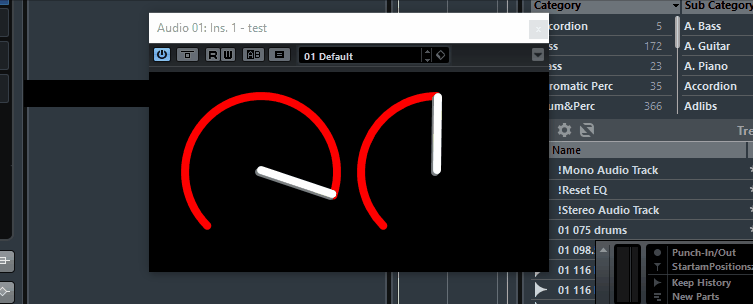I’ve had multiple users reporting that on some Windows setups the mousewheel affects multiple (non-overlapping) controls and I finally had the chance to boil down the issue. I’m sure that this is in fact a bug in VSTGUI and not related to my particular implementation whatsoever, see below.
It can be reproduced on e.g. Windows 10, Cubase 8 or newer in 64 Bits and only occurs when the zoom factor is set to anything other than 1.0 via CFrame::setZoom().
Here is a quick demonstration of what happens:

Below is a VSTGUI only code snippet that outlines a minimal editor implementation that allows to reproduce the issue. If you play around with the two knobs a little, it should be easy to hit a state in which both knobs are “linked”. I haven’t yet figured out any further systematics except for the prerequisites mentioned above. This does not happen for normal click+drag editing, so I’m guessing the root probably sits in the cases WM_MOUSEWHEEL and WM_MOUSEHWHEEL in Win32Frame::proc() or the IPlatformFrameCallback::platformOnMouseWheel() implementation.
static const double scale = 2;
static const CCoord width = 200;
static const CCoord height = 100;
class TestView :
public VSTGUIEditor,
public IControlListener
{
public:
TestView(EditController* controller) : VSTGUIEditor(controller)
{
rect.left = 0;
rect.top = 0;
rect.right = int32(scale * width);
rect.bottom = int32(scale * height);
}
virtual ~TestView()
{
}
virtual bool PLUGIN_API open(void* parent, const PlatformType& platformType = kDefaultNative)
{
if(frame)
frame->forget();
CRect size(0, 0, width, height);
frame = new CFrame(size, this);
if(frame && frame->open(parent, platformType))
{
frame->setBackgroundColor(kBlackCColor);
// Add two knobs to demonstrate the odd mousewheel behavior
CRect knobSize(0, 0, 0.8*height, 0.8*height);
knobSize.centerInside(size);
knobSize.offset(-knobSize.getWidth()/2.0 - 4.0, 0);
auto knob1 = new CKnob(knobSize, this, -1, nullptr, nullptr);
knob1->setDrawStyle(CKnob::kCoronaDrawing);
knob1->setCoronaColor(kRedCColor);
knob1->setCoronaInset(2.0);
knob1->setHandleLineWidth(4.0);
knob1->setValue(0.5f);
frame->addView(knob1);
knobSize.centerInside(size);
knobSize.offset(+knobSize.getWidth()/2.0 + 4.0, 0);
auto knob2 = new CKnob(knobSize, this, -1, nullptr, nullptr);
knob2->setDrawStyle(CKnob::kCoronaDrawing);
knob2->setCoronaColor(kRedCColor);
knob2->setCoronaInset(2.0);
knob2->setHandleLineWidth(4.0);
knob2->setValue(0.5f);
frame->addView(knob2);
// Mousewheel editing works flawlessly when scale == 1.0
frame->setZoom(scale);
return true;
}
return false;
}
virtual void PLUGIN_API close()
{
if(frame)
{
frame->close();
frame = nullptr;
}
}
virtual void valueChanged(CControl* pControl)
{
// Do nothing here...
}
};
Best,
Ray